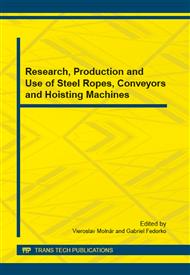p.102
p.108
p.114
p.119
p.125
p.130
p.135
p.142
p.147
Evaluation of the Effectiveness of an Eco-Friendly Technology for Splicing Steel Cord Conveyor Belts
Abstract:
A new eco-friendly method of splicing steel cord conveyor belts without the use of noxious materials has been developed by the Mining Institute at Wrocław University of Technology in collaboration with the Bełchatów Lignite Mine – the two leaders in implementing state-of-the-art and environment friendly technologies in mining in Poland [1,2,3]. Polish lignite mines use belts with steel cords. Such belts are spliced through high temperature vulcanization, which is not safe for the environment and has an adverse impact on human health. Strength and durability are the two main properties of belt splices, having a bearing on the failure-free operation of the belt conveyors used for the haulage of stripped rock or muck in open pit mines [4,5,6]. This means that properly made steel cord belt splices should have the strength and durability parameters similar to the ones of the belt without splices. Many factors contribute to the quality of the splice, including the ones connected with the splicing technology, workmanship and with the fact that splices are made directly on conveyors in heavy mine conditions.
Info:
Periodical:
Pages:
125-129
Citation:
Online since:
October 2014
Authors:
Price:
Сopyright:
© 2014 Trans Tech Publications Ltd. All Rights Reserved
Share:
Citation:


